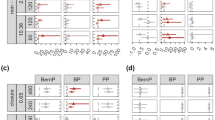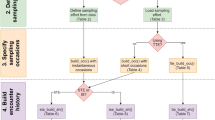Abstract
Camera trapping is widely used in ecological studies to estimate animal density, although these studies are largely restricted to animals that can be identified to the individual level. The random encounter model, developed by Rowcliffe et al. (J Anal Ecol 45(4):1228–1236, 2008), estimates animal density from camera-trap data without the need to identify animals. Although the REM can provide reliable density estimates, it lacks the potential to account for the multiple sources of variance in the modelling process. The density estimator in REM is a ratio, and since the variance of a ratio estimator is intractable, we examine and compare the finite sample performance of many approaches for obtaining confidence intervals via simulation studies. We also propose an integrated random encounter model as a parametric alternative, which is flexible and can incorporate covariates and random effects. A data example from Whipsnade Wild Animal Park, Bedfordshire, south England, is used to demonstrate the application of these methods.
Supplementary materials accompanying this paper appear on-line.
Similar content being viewed by others
References
Barrull, J., Mate, I., Ruiz-Olmo, J., Casanovas, J., Gosàlbez, J., and Salicrú, M. (2014). Factors and mechanisms that explain coexistence in a mediterranean carnivore assemblage: an integrated study based on camera trapping and diet. Mammalian Biology-Zeitschrift für Säugetierkunde, 79(2):123–131.
Besbeas, P., Freeman, S. N., Morgan, B. J., and Catchpole, E. A. (2002). Integrating mark–recapture–recovery and census data to estimate animal abundance and demographic parameters. Biometrics, 58(3):540–547.
Bridges, A. S. and Noss, A. J. (2011). Behavior and activity patterns. In Camera Traps in Animal Ecology, pp. 57–69. Springer.
Briggs, A. H., Mooney, C. Z., and Wonderling, D. E. (1999). Constructing confidence intervals for cost-effectiveness ratios: an evaluation of parametric and non-parametric techniques using monte carlo simulation. Statistics in Medicine, 18(23):3245–3262.
Buckland, S., Breiwick, J., Cattanach, K., and Laake, J. (1993). Estimated population size of the california gray whale. Marine Mammal Science, 9(3):235–249.
Buckland, S. T., Anderson, D. R., Burnham, K. P., Laake, J. L., Borchers, D., and Thomas, L. (2001). Introduction to distance sampling estimating abundance of biological populations.
Burton, A. C., Neilson, E., Moreira, D., Ladle, A., Steenweg, R., Fisher, J. T., Bayne, E., and Boutin, S. (2015). Wildlife camera trapping: a review and recommendations for linking surveys to ecological processes. Journal of Applied Ecology, 52(3):675–685.
Carbone, C., Christie, S., Conforti, K., Coulson, T., Franklin, N., Ginsberg, J., Griffiths, M., Holden, J., Kawanishi, K., Kinnaird, M., et al. (2001). The use of photographic rates to estimate densities of tigers and other cryptic mammals. In Animal Conservation Forum, vol 4, pp. 75–79. Cambridge: Cambridge University Press.
Carpenter, J. and Bithell, J. (2000). Bootstrap confidence intervals: when, which, what? a practical guide for medical statisticians. Statistics in medicine, 19(9):1141–1164.
Chandler, R. B., Royle, J. A., et al. (2013). Spatially explicit models for inference about density in unmarked or partially marked populations. The Annals of Applied Statistics, 7(2):936–954.
Chaudhary, M. A. and Stearns, S. C. (1996). Estimating confidence intervals for cost-effectiveness ratios: an example from a randomized trial. Statistics in Medicine, 15(13):1447–1458.
Cole, D. J. and McCrea, R. S. (2016). Parameter redundancy in discrete state-space and integrated models. Biometrical Journal, 58(5):1071–1090.
Cole, D. J., Morgan, B. J., and Ridout, M. S. (2003). Generalized linear mixed models for strawberry inflorescence data. Statistical Modelling, 3(4):273–290.
Dinh, P. and Zhou, X.-H. (2006). Nonparametric statistical methods for cost-effectiveness analyses. Biometrics, 62(2):576–588.
Dufour, J.-M. (1997). Some impossibility theorems in econometrics with applications to structural and dynamic models. Econometrica: Journal of the Econometric Society, pp. 1365–1387.
Efford, M. G., Dawson, D. K., and Borchers, D. L. (2009). Population density estimated from locations of individuals on a passive detector array. Ecology, 90(10):2676–2682.
Fieller, E. C. (1944). A fundamental formula in the statistics of biological assay, and some applications. Quarterly Journal of Pharmacy and Pharmacology, 17(2):117–123.
Fieller, E. C. (1954). Some problems in interval estimation. Journal of the Royal Statistical Society: Series B (Methodological), 16(2):175–185.
Franz, V. H. (2007). Ratios: A short guide to confidence limits and proper use. arXiv preprint arXiv:0710.2024.
Gleser, L. J. and Hwang, J. T. (1987). The nonexistence of 100 (1-\(\alpha \))% confidence sets of finite expected diameter in errors-in-variables and related models. The Annals of Statistics, pp. 1351–1362.
Green, P. J. (1984). Iteratively reweighted least squares for maximum likelihood estimation, and some robust and resistant alternatives. Journal of the Royal Statistical Society. Series B (Methodological), pp. 149–192.
Hilbe, J. M. (2011). Negative Binomial Regression. Cambridge: Cambridge University Press.
Howe, E. J., Buckland, S. T., Després-Einspenner, M.-L., and Kühl, H. S. (2017). Distance sampling with camera traps. Methods in Ecology and Evolution, 8(11):1558–1565.
Hutchinson, J. and Waser, P. M. (2007). Use, misuse and extensions of “ideal gas” models of animal encounter. Biological Reviews, 82(3):335–359.
Jennelle, C. S., Runge, M. C., and MacKenzie, D. I. (2002). The use of photographic rates to estimate densities of tigers and other cryptic mammals: a comment on misleading conclusions. Animal Conservation, 5(2):119–120.
McCallum, J. (2013). Changing use of camera traps in mammalian field research: habitats, taxa and study types. Mammal Review, 43(3):196–206.
McCrea, R. S. and Morgan, B. J. (2014). Analysis of Capture-Recapture Data. Boca Raton: CRC Press.
Miller, D. L., Burt, M. L., Rexstad, E. A., and Thomas, L. (2013). Spatial models for distance sampling data: recent developments and future directions. Methods in Ecology and Evolution, 4(11):1001–1010.
Morgan, B. J. (2008). Applied Stochastic Modelling. Boca Raton: CRC press.
Newman, K., Buckland, S., Morgan, B. J., King, R., Borchers, D., Cole, D. J., Besbeas, P., Gimenez, O., and Thomas, L. (2014). Modelling Population Dynamics. New York: Springer.
O’Brien, B. J., Drummond, M. F., Labelle, R. J., and Willan, A. (1994). In search of power and significance: issues in the design and analysis of stochastic cost-effectiveness studies in health care. Medical Care, pp. 150–163.
O’Brien, T. G., Kinnaird, M. F., and Wibisono, H. T. (2003). Crouching tigers, hidden prey: Sumatran tiger and prey populations in a tropical forest landscape. In Animal Conservation Forum, volume 6, pp. 131–139. Cambridge: Cambridge University Press.
Polsky, D., Glick, H. A., Willke, R., et al. (1997). Confidence intervals for cost-effectiveness ratios: a comparison of four methods. Health Economics, 6(3):243–252.
Puth, M.-T., Neuhäuser, M., and Ruxton, G. D. (2015). On the variety of methods for calculating confidence intervals by bootstrapping. Journal of Animal Ecology, 84(4):892–897.
R Core Team (2017). R: A Language and Environment for Statistical Computing. R Foundation for Statistical Computing, Vienna, Austria.
Ridout, M. S. and Linkie, M. (2009). Estimating overlap of daily activity patterns from camera trap data. Journal of Agricultural, Biological, and Environmental Statistics, 14(3):322–337.
Rowcliffe, J. M., Field, J., Turvey, S. T., and Carbone, C. (2008). Estimating animal density using camera traps without the need for individual recognition. Journal of Applied Ecology, 45(4):1228–1236.
Rowcliffe, J. M., Kays, R., Carbone, C., and Jansen, P. A. (2013). Clarifying assumptions behind the estimation of animal density from camera trap rates. Journal of Wildlife Management.
Rowcliffe, M., Carbone, C., Jansen, P. A., Kays, R., and Kranstauber, B. (2011). Quantifying the sensitivity of camera traps: an adapted distance sampling approach. Methods in Ecology and Evolution, 2(5):464–476.
Royle, J. A. and Young, K. V. (2008). A hierarchical model for spatial capture–recapture data. Ecology, 89(8):2281–2289.
Satterthwaite, F. E. (1946). An approximate distribution of estimates of variance components. Biometrics Bulletin, 2(6):110–114.
Sherman, M., Maity, A., and Wang, S. (2011). Inferences for the ratio: Fieller’s interval, log ratio, and large sample based confidence intervals. AStA Advances in Statistical Analysis, 95(3):313.
Van Kempen, G. and Van Vliet, L. (2000). Mean and variance of ratio estimators used in fluorescence ratio imaging. Cytometry Part A, 39(4):300–305.
Winkelmann, R. (2008). Econometric Analysis of Count Data. New York: Springer.
Zhou, M., McCrea, R. S., Matechou, E., Cole, D. J., and Griffths, R. A. (2019). Removal models accounting for temporary emigration. Biometrics, 75:24–35.
Acknowledgements
FUNDING This work was carried out as part and funded by the University of Kent 50th Anniversary Postgraduate Project and Engineering and Physical Sciences Research Council (EP/1000917/1-via St Andrews)
Author information
Authors and Affiliations
Corresponding author
Additional information
Publisher's Note
Springer Nature remains neutral with regard to jurisdictional claims in published maps and institutional affiliations.
Electronic supplementary material
Below is the link to the electronic supplementary material.
Rights and permissions
About this article
Cite this article
Jourdain, N.O.A.S., Cole, D.J., Ridout, M.S. et al. Statistical Development of Animal Density Estimation Using Random Encounter Modelling. JABES 25, 148–167 (2020). https://doi.org/10.1007/s13253-020-00385-4
Received:
Accepted:
Published:
Issue Date:
DOI: https://doi.org/10.1007/s13253-020-00385-4




